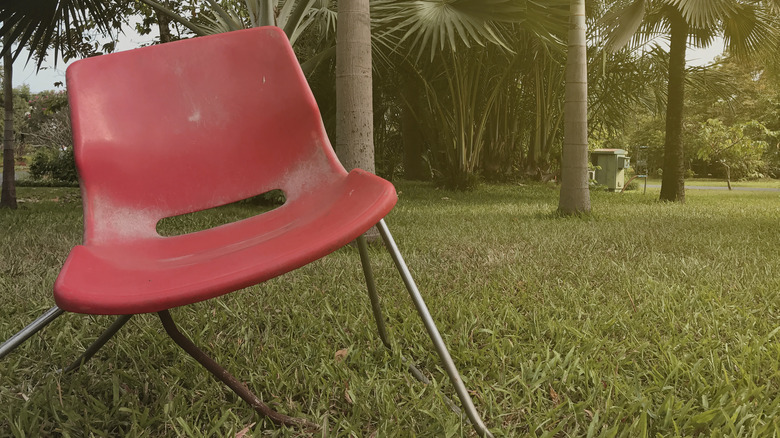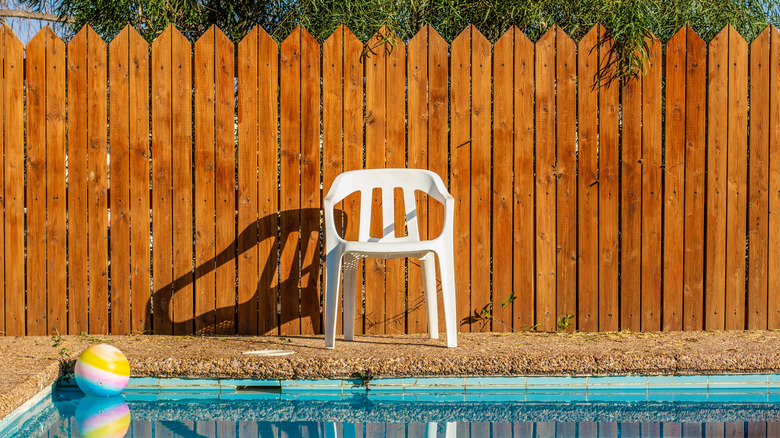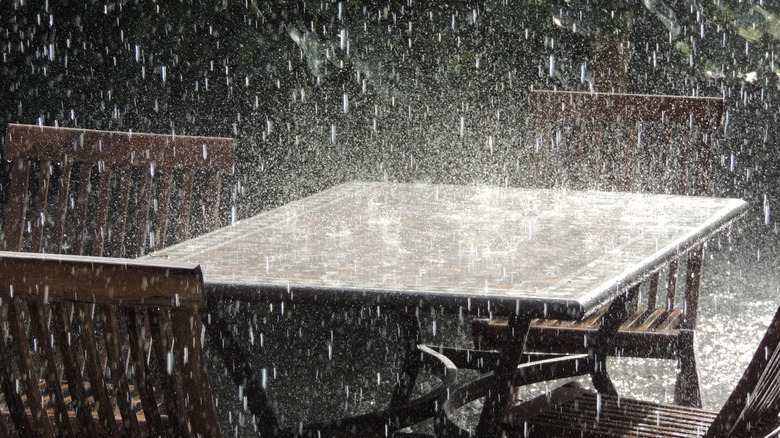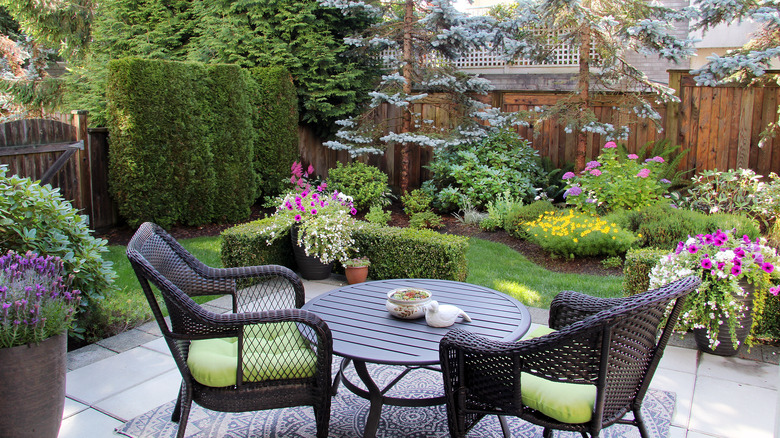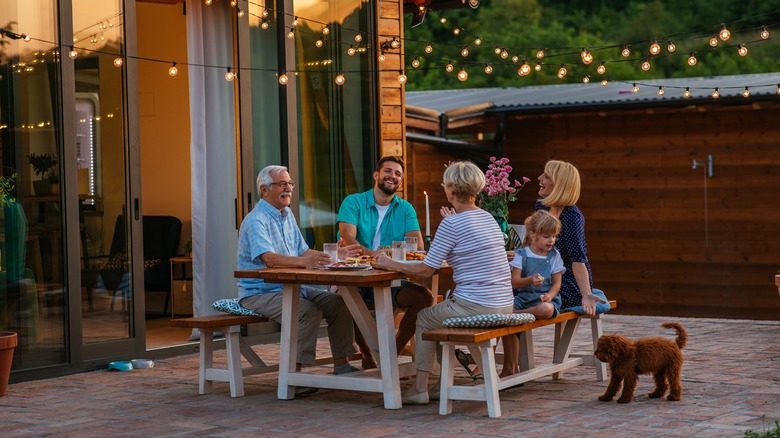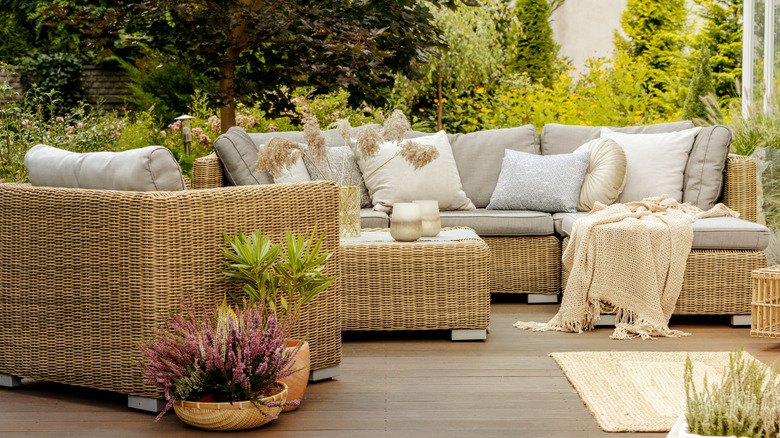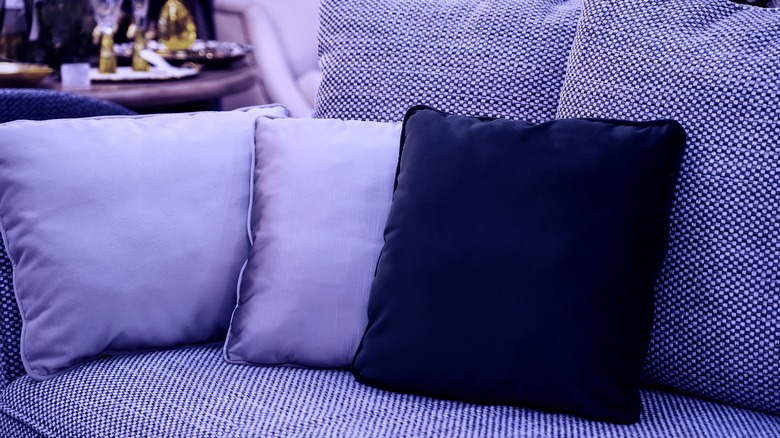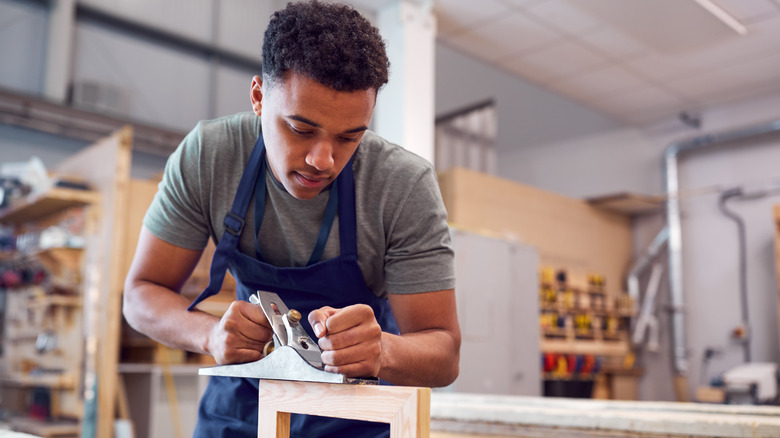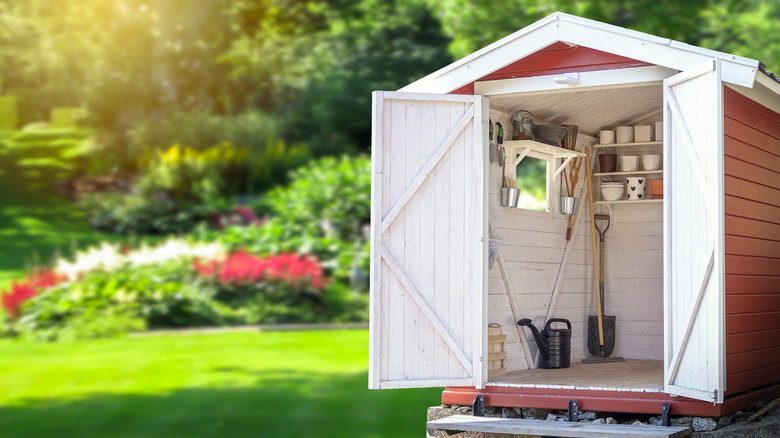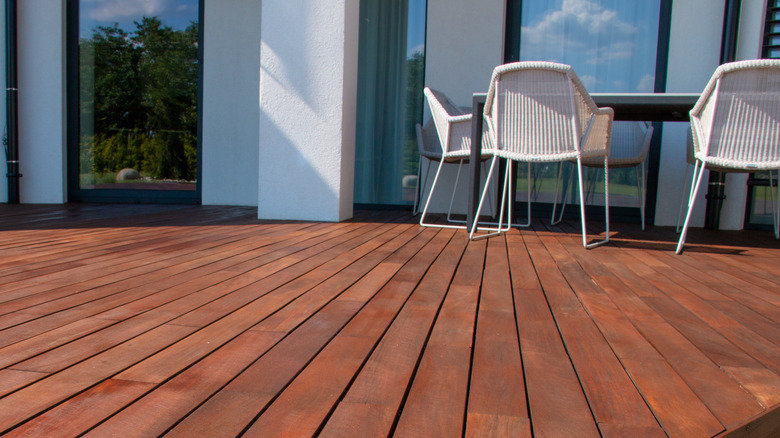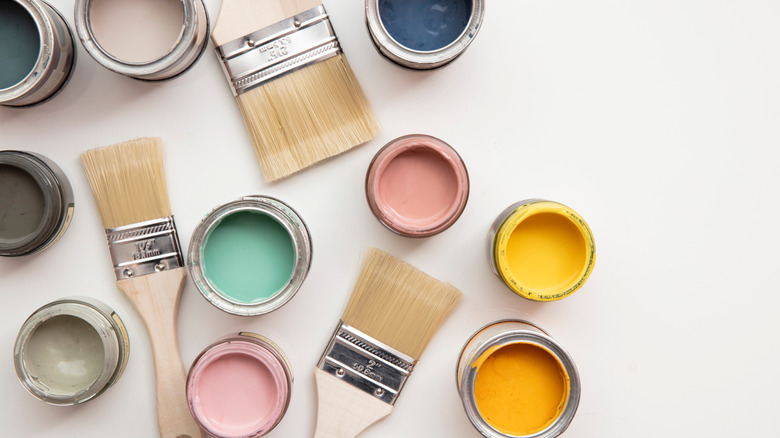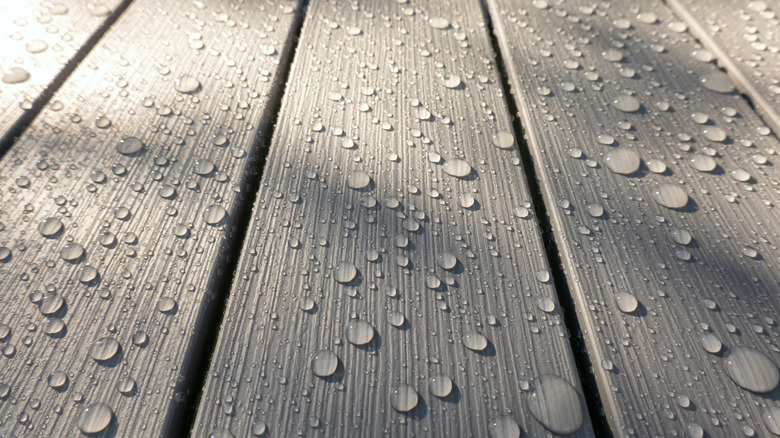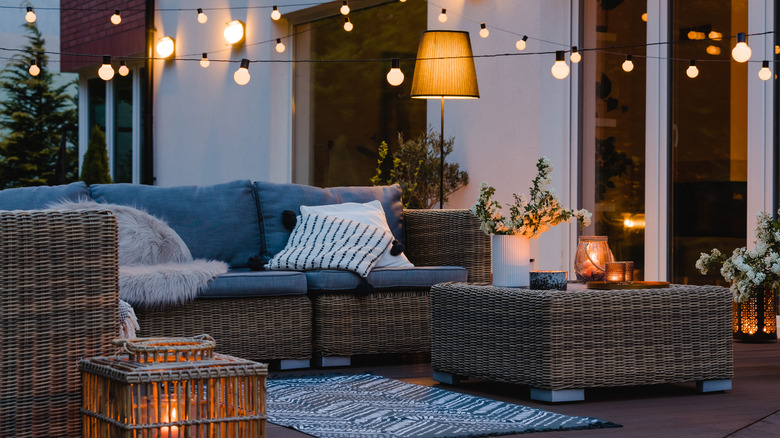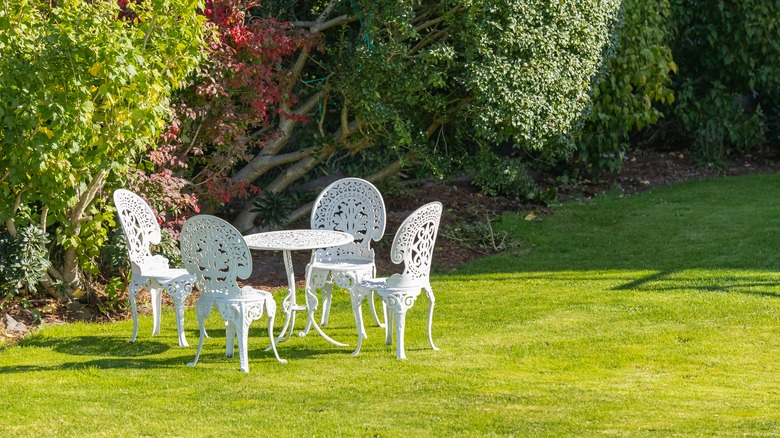Mistakes Everyone Makes When Buying Outdoor Furniture
The allure of a good outdoor space is hard to resist. Imagine a place for your family and friends to hang out, the barbecue sizzling away in the background as you nurse a glass of something cold, the sun streaming onto your face ... let's face it, folks, it's heaven. When planning the outdoor space of your dreams, do so with love and attention to detail. According to House Beautiful, outdoor areas should receive the same care as the indoor spaces in your home. Pay attention to layout, visual appeal, and function.
Naturally, this extends to the landscaping of your outdoor spaces and the furniture you're putting in them. It's easy to think that buying outdoor furniture is as simple as throwing a few patio chairs down, but in reality, there are a lot of specifics to consider. And there are a lot of mistakes you can make along the way. Read on for the most common mistakes people make when buying outdoor furniture and how to avoid them.
Trying to do it on the cheap
We typically don't hold our outdoor furniture to the same standard as our indoor items. Whether it's because we assume they will deteriorate quicker or because we don't use them as much during the year, cutting costs on outdoor furniture may leave you with some serious regrets.
According to Real Homes, it's best to avoid budget furnishings. Even though they might look nice in a professional photoshoot, the reality is that they usually will not withstand outdoor elements like rain or hot sun. While it might be tempting to save some money, cheaper furnishings often don't pass the test of time. For example, opting for the budget version of that silk throw pillow from a style blog you love will probably lead to disaster. While there's no need to spend a fortune on outdoor furniture, it's good to invest in higher-quality pieces that will last for more than a few months.
Not trying before you buy
In a world dominated by online shopping, it's never been more of a hassle to test items before buying. However, it's worth the effort to check outdoor furniture before taking it home. According to Better Homes & Gardens, you might use your outdoor furniture more than you think, especially in the spring and summer. Check furnishings for comfort, general sturdiness, and build quality to make sure that you and your guests can enjoy pieces for years to come.
As such, try as much as possible to find furniture items in a store where you can try them out first. Seeking out patio furniture with comfortable cushioning and seats will keep you happy during those long summer nights (via Better Homes and Gardens). If you're unable to find pieces with sturdy in-built cushions, you can always jazz up hard outdoor furniture with comfortable pillows — just make sure they're suitable for outdoor use.
Buying furniture that isn't weatherproof
So, you've seen a chair that you love. While not specifically made for outdoor use, it seems sturdy enough, and the cushioning feels like it'll be fine to withstand a few showers ... surely it'll be okay, right? This line of thought may leave you seriously out of pocket in the long run since you will probably have to replace your outdoor furniture with alarming frequency.
Instead, make sure the furniture you're buying features a weatherproof design. As designer Jennifer Newman said to Homes & Gardens, "Outdoor furniture does not need to be waterproof, like a roof, but it does need to keep water from being absorbed into the surfaces." If your outdoor furniture has a protective base material, it will be able to survive harsh weather. While it's important to buy outdoor furniture made for your specific climate, even the warmest places get rainfall now and again. Buying furniture equipped to withstand all weather will save the hassle of moving things inside when the rain comes.
Failing to consider the size of your space
Most people have to pay attention to space when designing their outdoor areas. Even if space is no object, it still takes careful consideration to decide what to do with it all. According to Hilltop Garden Centre, size is the first thing you should consider when buying furniture for your outdoor space. Treat your outdoor space in exactly the same way as you would the rooms in your home when buying furniture.
So, how do you handle the size consideration? It's all about measurements (via Hilltop Garden Centre). Measuring the size of your space will help you make an informed decision, and avoid purchasing items that are too big or too small. If you're buying items from an in-person store, enquire about the measurements (or take your own tape measure in — trust us, you'll be thankful for it later). For online purchases, check out the size of things before clicking add to basket. And remember to leave ample space between your furniture, too. The last thing you want is for things to feel cramped.
Not considering your specific needs and wants
It's surprisingly easy to lose your sense of individuality when designing outdoor spaces. A key question to consider when creating the backyard of your dreams is how you will use your outside living area. According to Out and Out, it's vital to remember that practicality is as important, if not even more so, than aesthetics when designing exterior spaces.
For example, if you use your outdoor space for frequent al fresco dining, buy a furniture set that reflects the maximum amount of people you'd have at one of your soirees. This tip will save you from awkwardly dragging kitchen chairs outside during a party. If you're keener on a "relaxing in the sun" vibe (and why wouldn't you be), then buy less formal furniture for lounging. And don't forget to consider age as a factor in all of this. If you have young kids, you'll need to ensure that your furniture is safety-proofed with no sharp edges or movable parts that could cause a problem down the line.
Having too much furniture
We all love outdoor furniture. Sometimes, we can love it a little too much. While we all want to fill up our patios with pieces that make our spaces sing, going overboard can quickly lead to a feeling of clutter. According to The Spruce, shoving too many items into an outdoor area can create a hemmed-in effect and make the space difficult to navigate. What's more, you may end up with an outdoor area that feels illogical and lacks cohesion.
Make careful design choices for your outdoor space and consider how they will complement your specific needs. Decorate with space in mind, accessorizing carefully and adding pieces as you see fit. Bear in mind that decorating too sparingly can create a different problem entirely. Outdoor spaces can feel aimless and unfinished if you don't have enough furniture. The last thing you want is an outdoor space you can't enjoy.
Selecting the right furniture for your garden
We apologize for raising a point that might be blindingly obvious, but you should consider whether the furniture you're buying will work for your unique garden space. According to Hilltop Garden Centre, if you don't plan how well items will work in your outdoor space, you could be left with a costly problem on your hands. For example, furniture pieces with heavy fabric can damage a garden. Chairs with thin legs might get caught between deck slats or sink into your lawn.
You should also keep in mind that not all furniture suits garden environments in terms of longevity. Placing metal furniture outside in ocean climates increases the chance of erosion or rust since the salt in the air interacts with the materials. Placing furniture under trees or other hanging objects also increases the chance of things falling on them. At best this results in a clean-up operation, while at worst it will require a repair job.
Ignoring safety concerns
The safety of our outdoor furniture needs to be a top priority. According to UL, the amount of safety incidents related to outdoor furniture use is significant. Around 3 million furniture items for outdoor use were sent back to manufacturers due to posing a safety risk from 2016 to 2018 (via UL). This fact highlights the need to make sure pieces are well-designed and safe for use in our backyards.
Off the back of this, UL partnered with Home Depot to introduce stringent certification for outdoor furniture safety. They implemented the UL 4041 safety program to help ensure outdoor pieces meet relevant safety criteria like strength, stability, corrosion, and endurance. Ensuring your furniture is certified with UL 4041 will help you buy confidently. If your supplier does not certify their outdoor furniture with UL 4041, it's good to determine if the pieces still meet standard safety criteria.
Neglecting to add storage
We are firm believers that you can never have too much outdoor storage space. However, it's easy to forget about this detail when shopping for outdoor furniture. Passing up storage space when you're buying patio pieces is a mistake that could leave you with too much clutter on your hands. As garden designer Chris Harrington said to Real Homes, "You can dress your patio as like you dress an indoor space, but have storage in your garden to put everything away."
Procuring outdoor storage for your backyard is always a good idea. Just remember to keep it separate from your furniture. Opting for large, waterproof storage will not only help you store your furniture pieces and accessories but can also double as a space to put away your gardening tools. Just make sure that whatever you buy works with the general aesthetic of your garden (via Storables).
Getting caught out with your chair legs
We can get so wrapped up in how sitting in a chair feels that we can sometimes forget to consider the legs. A good set of legs can literally make or break a chair, especially since fragile legs can pose a safety hazard. Failing to consider them when you buy outdoor furniture can cause undesirable results. According to Gardenista, buying chair legs that are too skinny can be a total nightmare on exterior decks, no matter how good they look. Particularly slim legs can easily slip between the gaps in decking, making them tricky to navigate for you and your guests.
The solution? Think about where your chairs will go and whether they'll be too skinny or cumbersome. It's also worth thinking about any plans you have for your garden. If you've got your eye on a new deck, consider playing it safe and going for chairs with sturdier legs so you won't have to buy an entirely new set of furniture later on.
Choosing clashing colors
It's only natural that outdoor spaces are the last spot we design in our homes. Once you finally get around to the garden or deck area, you might feel fatigued. To avoid potential design disasters, dig deep and unleash your great design sense one more time to make your outdoor furniture the best it can be.
According to Better Homes & Gardens, you don't have to stick to the standard neutrals and wood tones that usually dominate outdoor furnishings. Intelligent design pairs furniture with your home's color palette and landscape or ties into the specific architecture of your property. It's also a viable option to buy outdoor furniture with neutral tones and paint it the color of your choice. The cardinal rule is to avoid ugly color clashes and keep things cohesive. You don't want your outdoor spaces to feel like an afterthought. Make this space elegant, stylish, and well-considered.
Not preparing for a rainy day
Sooner or later in life, you'll be caught out in some dark storm clouds (and we don't just mean metaphorically). When those rainy days come, you need to ensure that your outdoor furniture can handle them. Buying weatherproof furniture will help ensure your outdoor space can survive a storm.
According to Gardenista, when buying furniture accessories like cushions, don't be lulled into a false sense of security by seeing the term "weatherproof." When the rain is pouring down, you'll likely need to get some further protection to avoid any lasting damage or mildew. Investing in some robust waterproof outdoor storage can be an ideal long-term solution to protect pieces that are more likely to get damaged by extreme weather, or you can always find storage space for them inside your home. If you have wooden furnishings, buy some protective coverings to prevent water damage.
Forgetting to accessorize
When it comes to outdoor furniture, the beauty is in the detail. While it seems easy to throw down a few lawn chairs and call it a day, for a truly exceptional outdoor space, you'll need to add some accessories to your shopping cart. According to The Spruce, incorporating accessories in your outdoor furniture design will help brighten up furniture sets that can traditionally be neutral-heavy, adding color and visual interest.
Remember, there's more to accessorizing outdoor spaces than just adding a few throw cushions. Add tasteful greenery in your garden by arranging planter pots around a concrete patio, or add some outdoor lighting with patio lights (via Erdmann Exteriors). To take things to the next level, add in a fire pit to create a natural focal point for your garden. Ensure that any accessories you're buying are explicitly designed for outdoor use to save you from having to lug things back inside at the end of every day. Try to keep the balance with your additions, too. Having too many accessories can leave a garden feeling cluttered and busy.
Not considering your four-legged friend
Our cats and dogs want to enjoy our gardens are much as we do. However, as any pet owner knows, furniture can quickly deteriorate around our furry pals. In an outdoor setting, furniture can be surprisingly susceptible to pet-related damage, despite the apparent sturdiness of these pieces. One particular problem area is around wooden decking and your dogs' potential need to relieve itself on it. As Jamie Penney of The Backyard Pros said to Real Homes, "This causes severe discoloration on the deck requiring power washing and sanding. It also can damage the wood, causing rot."
This problem is one of the reasons why choosing pet-friendly furniture. Choosing garden furniture with sturdier materials, like wrought iron or aluminum, can help prevent chewing damage from pets (via Sunniland Patio). If you're still leaning towards wood, using Ipe wood for your furniture or decking is an excellent choice since the natural oils in the wood type operate as a deterrent to most dogs. Ensure that you use furniture covers to prevent scratching damage from cats and dogs and minimize animal hair build-up.
Finding the right furniture materials
Like indoor furniture, outdoor pieces come in a wide range of materials. While it's easy to assume that your choice comes down to style alone, choosing a material involves more than aesthetics. Considering your individual needs around materials will help you make a furniture choice that won't need replacing or deteriorate too quickly. According to Out & Out, if you have young children, choose wipe-clean stainless steel or resin furniture to help with post-meal cleanup.
Similarly, pieces made of poly rattan can emulate the look of rattan furniture without breaking down as quickly as the natural fiber. When choosing outdoor furniture, always weigh your options by considering essentials like function, aesthetic presentation, durability, and suitability to your local climate (via Patio Productions). Consider weight and price too. For example, items made of steel may be super-durable, but they can also be surprisingly pricey and heavy.

